8.3 Planetary Rings
In addition to their moons, all four of the giant planets have rings, with each ring system consisting of billions of small particles or “moonlets” orbiting close to their planet. Each of these rings displays a complicated structure that is related to interactions between the ring particles and the larger moons. However, the four ring systems are very different from each other in mass, structure, and composition, as outlined in Table 8.2.
| Planet | Outer Radius (km) |
Outer Radius (Rplanet) |
Mass (kg) |
Reflectivity (%) |
|---|---|---|---|---|
| Jupiter | 128,000 | 1.8 | 1010(?) | ? |
| Saturn | 140,000 | 2.3 | 1019 | 60 |
| Uranus | 51,000 | 2.2 | 1014 | 5 |
| Neptune | 63,000 | 2.5 | 1012 | 5 |
Rings of Saturn
Saturn’s rings are one of the most beautiful sights in the solar system (Figure 8.17). From outer to inner, the three brightest rings are labelled with the extremely unromantic names of A, B, and C Rings. Table 8.3 gives the dimensions of the rings in both kilometres and units of the radius of Saturn, RSaturn. The B Ring is the brightest and has the most closely packed particles, whereas the A and C Rings are translucent.
The total mass of the B Ring, which is probably close to the mass of the entire ring system, is about equal to that of an icy moon 250 kilometres in diameter (suggesting that the ring could have originated in the breakup of such a moon). Between the A and B Rings is a wide gap named the Cassini Division after Gian Domenico Cassini, who first glimpsed it through a telescope in 1675 and whose name planetary scientists also gave to the Cassini spacecraft that explored the Saturn system.
Saturn’s Rings as Seen from Above and Below
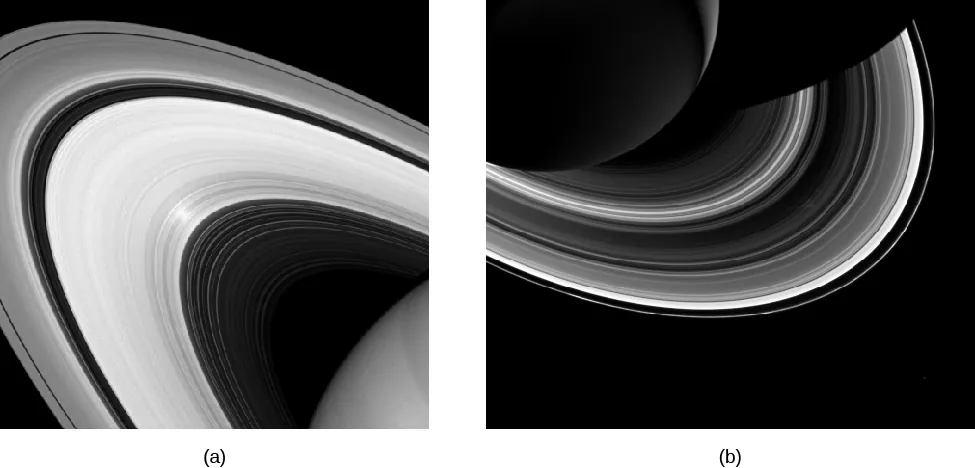
(a): PIA17152: Polarized Surge by NASA/JPL-Caltech/Space Science Institute, NASA Media Licence.
(b): PIA17154: Shadows and Rings by NASA/JPL-Caltech/Space Science Institute, NASA Media Licence.
| Ring Name3 | Outer Edge (RSaturn) |
Outer Edge (km) |
Width (km) |
|---|---|---|---|
| F | 2.324 | 140,180 | 90 |
| A | 2.267 | 136,780 | 14,600 |
| Cassini Division | 2.025 | 122,170 | 4590 |
| B | 1.949 | 117,580 | 25,580 |
| C | 1.525 | 92,000 | 17,490 |
Rings of Saturn as Seen from the Inside
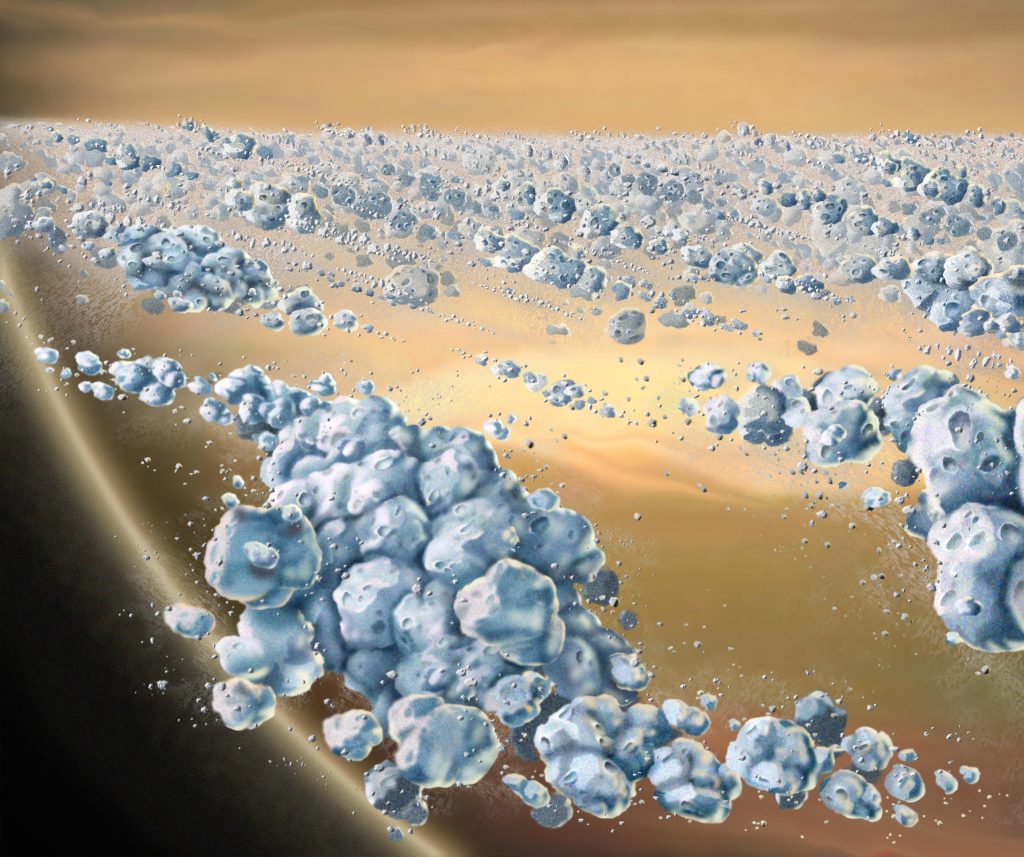
PIA10081: Saturn’s Recycling Rings by NASA/JPL/University of Colorado, NASA Media Licence.
Rings of Uranus and Neptune
Uranus’ rings are narrow and black, making them almost invisible from Earth. The nine main rings were discovered in 1977 from observations made of a star as Uranus passed in front of it. We call such a passage of one astronomical object in front of another an occultation. During the 1977 occultation, astronomers expected the star’s light to disappear as the planet moved across it. But in addition, the star dimmed briefly several times before Uranus reached it, as each narrow ring passed between the star and the telescope. Thus, the rings were mapped out in detail even though they could not be seen or photographed directly, like counting the number of cars in a train at night by watching the blinking of a light as the cars successively pass in front of it. When Voyager approached Uranus in 1986, it was able to study the rings at close range; the spacecraft also photographed two new rings (Figure 8.19).
Rings of Uranus
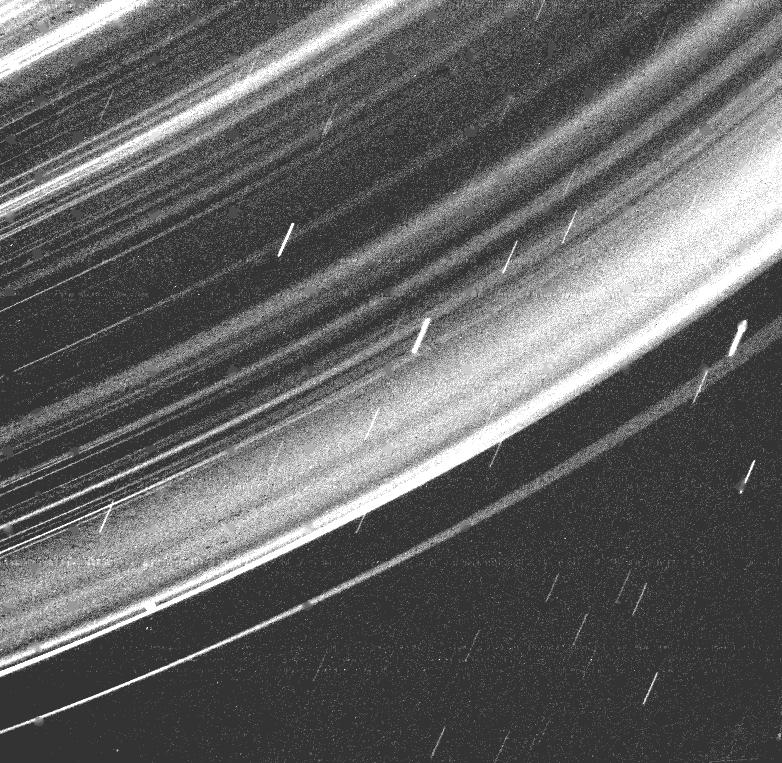
PIA00142: Uranus Ring System by NASA/JPL, NASA Media Licence.
The outermost and most massive of Uranus’ rings is called the Epsilon Ring. It is only about 100 kilometres wide and probably no more than 100 metres thick (similar to the F Ring of Saturn). The Epsilon Ring encircles Uranus at a distance of 51,000 kilometres, about twice the radius of Uranus. This ring probably contains as much mass as all of Uranus’ other ten rings combined; most of them are narrow ribbons less than 10 kilometres wide, just the reverse of the broad rings of Saturn.
The individual particles in the uranian rings are nearly as black as lumps of coal. While astronomers do not understand the composition of this material in detail, it seems to consist in large part of carbon and hydrocarbon compounds. Organic material of this sort is rather common in the outer solar system. Many of the asteroids and comets are also composed of dark, tarlike materials. In the case of Uranus, its ten small inner moons have a similar composition, suggesting that one or more moons might have broken up to make the rings.
Neptune’s rings are generally similar to those of Uranus but even more tenuous (Figure 8.20). There are only four of them, and the particles are not uniformly distributed along their lengths. Because these rings are so difficult to investigate from Earth, it will probably be a long time before we understand them very well.
Rings of Neptune
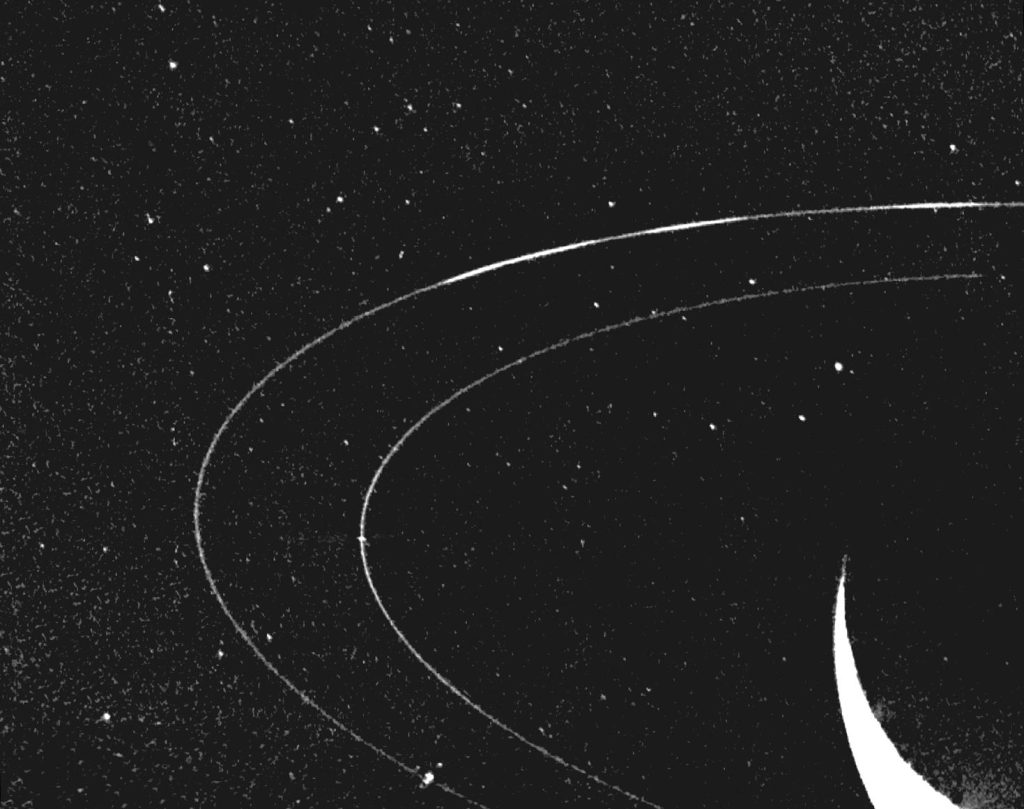
PIA01493: Neptune’s Rings by NASA/JPL, NASA Media Licence.
Interactions between Rings and Moons
Much of our fascination with planetary rings is a result of their intricate structures, most of which owe their existence to the gravitational effect of moons, without which the rings would be flat and featureless. Indeed, it is becoming clear that without moons there would probably be no rings at all because, left to themselves, thin disks of small particles gradually spread and dissipate.
Most of the gaps in Saturn’s rings, and also the location of the outer edge of the A Ring, result from gravitational resonances with small inner moons. A resonance takes place when two objects have orbital periods that are exact ratios of each other, such as 1:2 or 2:3. For example, any particle in the gap at the inner side of the Cassini Division of Saturn’s rings would have a period equal to one-half that of Saturn’s moon Mimas. Such a particle would be nearest Mimas in the same part of its orbit every second revolution. The repeated gravitational tugs of Mimas, acting always in the same direction, would perturb it, forcing it into a new orbit outside the gap. In this way, the Cassini Division became depleted of ring material over long periods of time.
The Cassini mission revealed a great deal of fine structure in Saturn’s rings. Unlike the earlier Voyager flybys, Cassini was able to observe the rings for more than a decade, revealing a remarkable range of changes, on time scales from a few minutes to several years. Many of the features newly seen in Cassini data indicated the presence of condensations or small moons only a few tens of metres across imbedded in the rings. As each small moon moves, it produces waves in the surrounding ring material like the wake left by a moving ship. Even when the moon is too small to be resolved, its characteristic waves could be photographed by Cassini.
One of the most interesting rings of Saturn is the narrow F Ring, which contains several apparent ringlets within its 90-kilometer width. In places, the F Ring breaks up into two or three parallel strands that sometimes show bends or kinks. Most of the rings of Uranus and Neptune are also narrow ribbons like the F Ring of Saturn. Clearly, the gravity of some objects must be keeping the particles in these thin rings from spreading out.
As we have seen, the largest features in the rings of Saturn are produced by gravitational resonances with the inner moons, while much of the fine structure is caused by smaller embedded moons. In the case of Saturn’s F Ring, close-up images revealed that it is bounded by the orbits of two moons, called Pandora and Prometheus (Figure 8.21). These two small moons (each about 100 kilometres in diameter) are referred to as shepherd moons, since their gravitation serves to “shepherd” the ring particles and keep them confined to a narrow ribbon. A similar situation applies to the Epsilon Ring of Uranus, which is shepherded by the moons Cordelia and Ophelia. These two shepherds, each about 50 kilometres in diameter, orbit about 2000 kilometres inside and outside the ring.
Saturn’s F Ring and Its Shepherd Moons
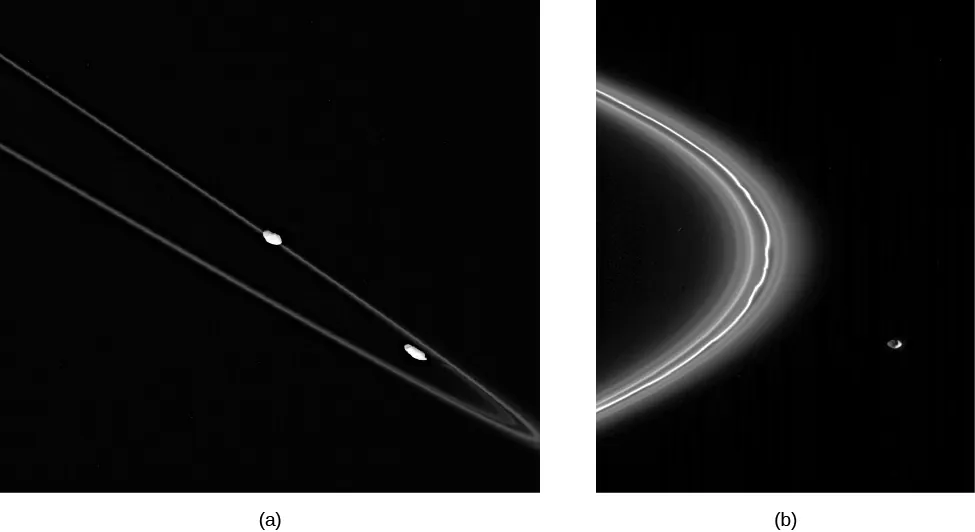
(a): PIA07653: Close to the Shepherd Moons by NASA/JPL/Space Science Institute, NASA Media Licence.
(b): PIA07523: Pandora’s Flocks by NASA/JPL/Space Science Institute, NASA Media Licence.
Attribution
“12.5 Planetary Rings (and Enceladus)” from Astronomy 2e by Andrew Fraknoi, David Morrison, Sidney C. Wolff, © OpenStax – Rice University is licensed under a Creative Commons Attribution 4.0 International License, except where otherwise noted.

